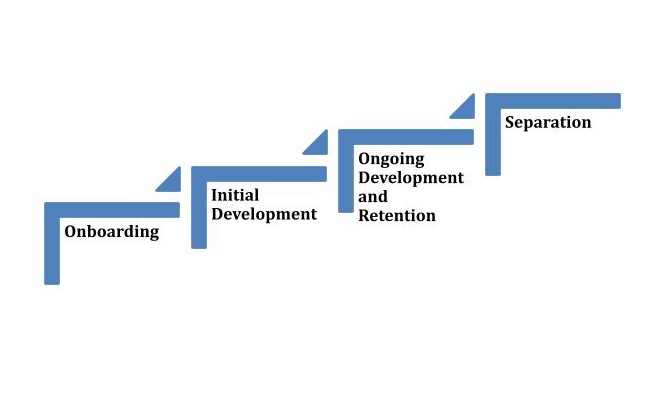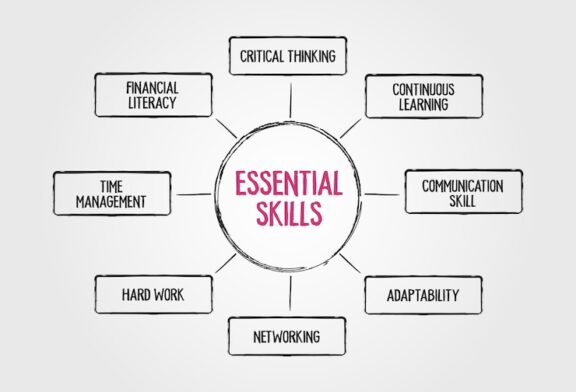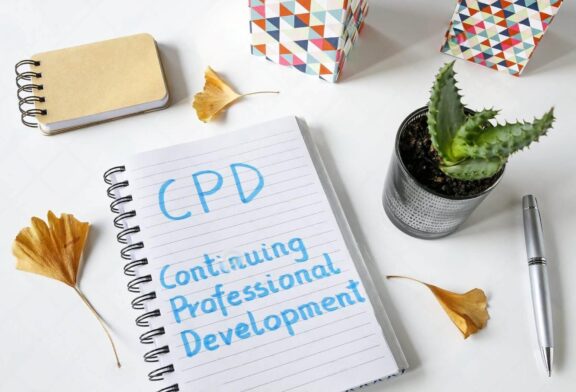In a workplace, any employee has a future career goal. It becomes the responsibility of the organisation and the leadership to help the employee achieve that career goal. It is in this context that organisations may consider initiatives referred to as employee development.

How can employee development be crucial to a workplace? What are the benefits of a workplace undertaking employee development initiatives? And what are the strategies that can maximise an employee’s future potential? This blog focuses on answering these questions.
What is Employee Development?
Employee development consists of the measures that the leadership of an organisation can take to ensure the growth of the workforce members towards their goals.
This process includes several procedures, the most notable of which would be the alignment of an employee’s personal goals with the overarching company goals.
Employee development initiatives have been considered significantly important for all modern workplaces. In fact, as per a LinkedIn study, 94% of employees continue to stay in a company that invests in their professional development. Thus, it not only develops employees but also aids in retention.
Difference Between Employee Training and Employee Development
Employee training is an essential subsection of employee development. However, these two interlinked concepts are different in some key areas. These key areas of difference are:
| Areas | Employee Training | Employee Development |
| Focus | Focuses on developing employee skills in their job role. | Focuses on developing an employee’s future career path. |
| Timeframe | Usually a limited, short-term process. | A continuous, long-term process. |
| Scope | Typically job-specific. | A more holistic strategy, encompassing both professional and personal growth. |
| Expected Outcome | Improved job performance and productivity. | Enhancing an employee’s long-term value to the organisation. Adds to career satisfaction. |
Table: Employee Training vs. Employee Development
What Are the Benefits of Employee Development?
Employee development plans in a workplace offer several benefits. These include:
Improving Individual Job Performance: As employees undergo development programs, they learn more about their job roles, along with the skills and capabilities required. This also improves the employee confidence levels. Allowing them to perform better, which further benefits employers with a confident and capable workforce.
Boosting Employee Morale: A focus on developing the career of employees by the organisation leads to them feeling more valued. As per a study, 80% of workers have said that learning and development helps their sense of purpose at work. It also improves engagement and commitment. Thus, their morale rises, leading employers to be able to foster a positive work culture.
Increasing Job Satisfaction: Development plans not only develop employee confidence, but they also help competence and career prospects, leading to more motivated and committed employees. This is a sign of job satisfaction. This satisfaction has been seen in 90% of employees who would prefer to stay at a company that provides them with development opportunities. This benefits employers as well, who can invest in workforce development practices, gaining a loyal and motivated team in return.
What Are the Four Stages of Employee Development?

Employee development is a continuous process that can be expressed as a multistage action plan. There are four overarching stages that take into consideration the career and development of an employee throughout their time at an organisation.
The stages are:
Onboarding
This stage shows that an employee’s development essentially begins when they are welcomed into the workforce of a company. In the onboarding process, an employee is informed of the job expectations, responsibilities, and performance goals.
A thorough onboarding process allows employees to understand what the organisation expects from them. This aids them in aligning their own career paths with what they can help the company achieve.
As per a Gallup study, an exceptional onboarding experience can lead to 2.6 times more job satisfaction from employees. Thus, with onboarding, employees receive the right motivation, a proper career plan, and a goal to strive for, i.e., a push towards development.
Thus, an effective onboarding process is like the starting nudge to employee development, accelerating the learning, increasing productivity, and setting the employee on a future career path.
The employer also benefits from this, as the recruits are being prepared at the initial stages of their careers. This leads to an easier integration of a productive workforce and creates a stronger work culture. This adds to the employer’s confidence in meeting the demands of a changing market.
Initial Development
In this stage, the initial employee growth plan is developed. This continues from the onboarding process by equipping recruits with the tools to succeed in their job roles. The two development tools that are commonly used in this stage are employee training and early mentorship.
Here, the new recruits gain key insights into their specific job role and performance expectations. This allows a new hire to quickly adapt to the environment and responsibilities, simplifying the adjustment process for the recruits and the employers.
Thus, an early investment in employee development can lead to improved job satisfaction and reduced staff turnover. That also impacts the employers, who now have a contented workforce, which will lead to an overall increase in organisational efficiency and productivity.
Moreover, as 91% of employees seek personalised and relevant training, an initial investment in the training processes can help employers identify what the workforce needs, leading to tailored training plans.
Ongoing Development and Retention
However, the employee development plan does not start and end at the initial stages. Employee development is, therefore, considered a set of continuous actions within an organisation.
The benefits of ongoing development initiatives include enhancing the skills of employees, boosting employee morale, improving employee performance, and fostering a culture of continuous learning and growth. This continuous learning process can further enhance an employer’s capability to gauge the workforce’s performance over time and adapt accordingly.
Here, the employees also receive a clear path for career progression within the company. Thus, job satisfaction and motivation are increased. Therefore, employee retention can be enhanced.
The investment in a continuous development plan has seen companies register a 58% higher employee retention, as per a 2023 HR Digest study. Higher employee retention has a significant positive impact on employers, with cost savings and improved workforce morale.
Separation
The separation stage, or the last stage of an employee’s life cycle within an organisation, is a stage of learning and development, as it can be an opportunity for self-development and creating new skills.
Whether the separation is voluntary or involuntary, it can be important to an employer’s understanding of what led to employees leaving. This can lead to working on improving the organisation’s systems to prevent this in the future. This can be explained with the following example:
As per a 2023 Gartner study, 45% of employees are burned out by major organisational changes, leading to separations. This can be one priority of employers in creating development plans that can help employees overcome this fatigue to change.
Furthermore, it opens the doors for new job opportunities, exposing employees to different work environments, skills, and technologies. Therefore, the departing employee can develop further skills, aiding overall career growth.
How to Strategise Employee Development
An organisation’s approach to employment and development needs to offer different strategies, especially to focus on aspects like reskilling, upskilling, and skill variety. The importance of strategy in employee development can be explained by this 2023 World Economic Forum Study, which has stated that 41% of workers have bridged skill gaps through training and development programs.
Therefore, focusing on strategising employee development can effectively address development through the aforementioned aspects, and bridging skill gaps.
Training
Training can be crucial for developing employee skills through reskilling and upskilling practices. These two are important factors to consider in employee development. It can be observed that 53% organisations have prioritised upskilling and reskilling as per a 2023-24 SHRM study.
Thus, training practices can help close skill gaps, preparing employees for future challenges and enhancing their resilience and adaptability. Therefore, this can be an effective strategy for employee development.
Coaching
Coaching can be an excellent strategy for developing employee job performance and aiding them to reach their professional goals. They can guide employees towards setting realistic goals within specific timeframes and achieving them.
Furthermore, experienced coaches can help employees develop a variety of skills to adapt to any possible challenging scenario. They also identify the best ways to help the employees align their personal goals with the overall goals of the organisation.
Mentorship
Mentorship is an employee growth plan where a relationship is fostered between a more experienced employee and a newer employee. In this relationship, the former guides the latter towards career development.
It is a more personalised approach to guidance, where the mentor offers tailored guidance to the mentee, leading to various results. These various results are also based on what the mentee needs. Upskilling and reskilling needs are also best addressed by personalised mentorship approaches.
Integrating an Employee Development Program
Companies with a level of strategic investment in employee development programs, according to a Gallup study, have reported 11% higher profitability along with a significant improvement in their employee retention.
Here are the steps you need to follow for this:
Implementation
After an employee development plan has been devised and has received the approval of the leadership and key stakeholders, you should implement it by:
- Providing employees with the required necessities and guidance for development.
- Supporting the development initiatives and fostering a continuous learning culture.
- Providing the trainees with constructive feedback that can help them perfect the application of the developed skills.
Evaluation
Now, having implemented the plan, does it stay static? No, you need to gather relevant information and ensure that the plan adapts to changing organisational needs, and refine the plan. This can be achieved by considering:
- Accepting employee feedback.
- Identifying areas of improvement and working on them.
- Ensuring that the development plan aligns with the organisational goals.
- A continuous learning and evaluation-based system is followed.
Summing Up
In an organisation, to ensure continuous growth, refining the workforce becomes really important. This is where employee development comes in. It can help your company retain employees better, while the employees will be better prepared to handle a dynamic market environment.
A development plan that grows with its employees and helps them grow as well, can be the ideal employee development approach.
Driving Growth Through Effective Employee Development
Taking the correct approach to helping your company grow can be a simple set of processes. Devise strategies to help and guide your workforce to address a changing market scenario. And with that, if you can ensure that this plan meets your organisation’s long-term goals, the ideal employee learning and development plan is made!




